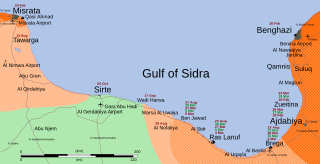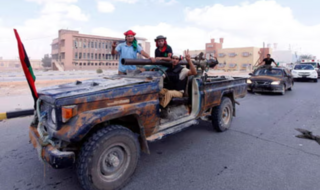
Misrata or Misratah, also known by the Italian spelling Misurata, is a city in the Misrata District in northwestern Libya, situated 187 km (116 mi) to the east of Tripoli and 825 km (513 mi) west of Benghazi on the Mediterranean coast near Cape Misrata. With a population of about 881,000, it is the third-largest city in Libya, after Tripoli and Benghazi. It is the capital city of the Misrata District and has been called the trade capital of Libya. The harbor is at Qasr Ahmad.

Wanis al-Qaddafi was a Libyan politician. He held many positions in the era of the Kingdom of Libya and was the tenth Prime Minister of Libya from 4 September 1968 to 31 August 1969, when his government was overthrown by Muammar Gaddafi.
"Libya, Libya, Libya", also known as "Ya Beladi", is the national anthem of Libya since 2011; it was previously the national anthem of the Kingdom of Libya from 1955 to 1969. It was composed by Mohammed Abdel Wahab, in 1951, with the lyrics being written by Al Bashir Al Arebi.

The battle of Misrata, also known as the siege of Misrata, was a battle of the 2011 Libyan Civil War for the control of Misrata. It was fought between troops loyal to the government of Muammar Gaddafi, and anti-Gaddafi rebels who held Misrata, the third largest city in Libya. Following the initial stages of the uprising, the Libyan government took back most towns in the west of the country, leaving Misrata the only major city under rebel control in Tripolitania. The city soon became the site of one of the war's major battles and the suffering of its citizens gained worldwide attention.

The National Liberation Army, officially the National Liberation Armed Forces of the Free Libyan Republic, formerly known as the Free Libyan Army, was a Libyan military organisation affiliated with the National Transitional Council, which was constituted during the First Libyan Civil War by defected military members and civilian volunteers, in order to engage in battle against both remaining members of the Libyan Armed Forces and paramilitia loyal to the rule of Muammar Gaddafi. Its self proclaimed chief commander was General Khalifa Haftar, although the National Transitional Council preferred to appoint Major General Abdul Fatah Younes Al-Obeidi as its commander-in-chief. It had prepared for some time in portions of Eastern Libya controlled by the anti-Gaddafi forces for eventual full-on combat in Western Libya against pro-Gaddafi militants, training many men before beginning to go on the offensive. They have battled for control of Benghazi, Misrata, Brega, Ajdabiya, Zawiya and Ra's Lanuf as well as several towns in the Nafusa Mountains. They finally began the Battle for Tripoli in August 2011 when they attacked from the west of the city, as well as fomenting an internal uprising on 20 August.
The outbreak of the Libyan Civil War was followed by accusations of human rights violations by rebel forces opposed to Muammar Gaddafi, Gaddafi's armed forces, and NATO. The alleged violations include rape, extrajudicial killings, ethnic cleansing, misconduct and bombings of civilians.
The Battle of the Misrata frontline was a battle during the Libyan Civil War between pro-Gaddafi loyalists and anti-Gaddafi forces on the western and southwestern outskirts of Misrata, the third largest city in Libya. It ended when anti-Gaddafi soldiers secured Zliten to the west and Tawergha to the south, establishing a significant buffer zone around the city.

The timeline of the First Libyan Civil War begins on 15 February 2011 and ends on 20 October 2011. It begins with a series of peaceful protests, similar to others of the Arab Spring, later becoming a full-scale civil war between the forces loyal to Muammar Gaddafi's government and the anti-Gaddafi forces. The conflict can roughly be divided into two periods before and after external military intervention authorized by United Nations Security Council Resolution 1973.
The Battle of Tawergha was a military engagement of the Libyan Civil War that began on 11 August 2011 when anti-Gaddafi forces based in Misrata advanced southeast along the road to Sirte in the early morning and attacked Libyan Army positions in the town of Tawergha. It ended on 13 August when rebel troops, after capturing the town, cleared it of snipers and artillery positions threatening Misrata.

The Libyan Civil War began on 15 February 2011 as a civil protest and later evolved into a widespread uprising. However, by 19 March, Libyan forces under Colonel Muammar Gaddafi were on the brink of a decisive victory over rebels in Libya's east. That day, leading NATO members acted on United Nations Security Council Resolution 1973 which authorized member states "to take all necessary measures... to protect civilians and civilian populated areas under threat of attack in the Libyan Arab Jamahiriya, including Benghazi, while excluding an occupation force".

The Second Gulf of Sidra offensive was a military operation in the First Libyan Civil War conducted by rebel anti-Gaddafi forces in August and September 2011 to take control of towns along the Gulf of Sidra in an effort to surround Muammar Gaddafi's hometown of Sirte, which was held by pro-Gaddafi forces. It ended on 20 October, with the capture and execution of Muammar Gaddafi and his son Mutassim Gaddafi, along with former defense minister Abu-Bakr Yunis Jabr. The Gaddafi loyalists in the area were finally defeated when NTC fighters captured Sirte.

The siege of Bani Walid was a military conflict in Libya.
This is a detailed timeline of the Libyan civil war (2014–2020) which lasted from 2014 to 2020.

The Misrata War Museum contains a collection of weapons, photos and objects linked to the Libyan War of 2011. It is located in the Libyan city of Misrata.

The Western Libya campaign was a military campaign initiated on 4 April 2019 by the Operation Flood of Dignity of the Libyan National Army, which represents the Libyan House of Representatives, to capture the western region of Libya and eventually the capital Tripoli held by the United Nations Security Council-recognised Government of National Accord. The Government of National Accord regained control over all of Tripoli in June 2020 and the LNA forces withdrew from the capital, after fourteen months of fighting.

The Battle of Bayda was the first conflict that broke out during the First Libyan Civil War between the brigades of Colonel Muammar Gaddafi and the Libyan rebels in the 4th-largest city in the country, the city of Bayda and its suburbs. The battle took place as a result of the demonstrations calling for the fall of the regime in Bayda, and after that the demonstrators clashed with the internal security in the city and the Talaa Khamis Brigade and the mercenaries and the Hussein Al-Jouifi Brigade stationed in Shahhat and Al Abraq International Airport in Bayda. The fighting continued one day in Bayda and the city was liberated, and then the Libyan revolutionaries headed to the outskirts of the city in Shahhat and Al-Abraq Airport. The revolutionaries were able to control the city and its suburbs, and thus Bayda was the first city to break out of Gaddafi's control and remained under their control throughout the revolution.
Wissam Bin Hamid was a Libyan jihadist militant and warload.
The Misrata Military Council, also commonly referred to as the Misrata Brigades, or the Misrata Revolutionary Brigades, are armed units linked to the town of Misrata and its surrounding area, allied to, but separate from, the Libyan Army. They are the largest and strongest military unit in all of Libya, consisting of 40,000 fighters with over 200 battalions, making them the largest block of fighters. The Misrata Brigades played a large part in the Libyan Revolution, which overthrew Gaddafi, as well as the Second Libyan Civil War in which they fought the Libyan National Army as well as ISIL in Sirte.

The Misrata Massacre refers to a series of violent events that occurred in the Libyan city of Misrata from 21 March to 23 March, amidst the broader conflict between forces loyal to Libyan leader Muammar Gaddafi and opposition rebels. These events resulted in significant loss of civilian lives, widespread destruction of property, and reports of human rights violations.

The Abu Salim Massacre was a massacre that took place in Abu Salim prison and was perpetrated by Muammar Gaddafi. It is consided to be one of the worst events perpetrated by the Gaddafi regime. This massacre was one of the most prominent factors that helped spark the Libyan revolution in 2011.












